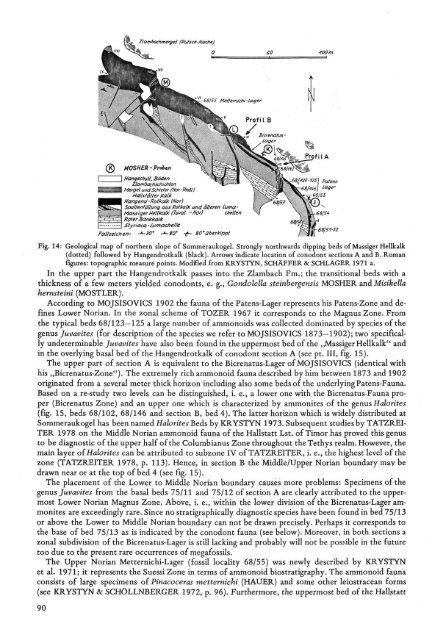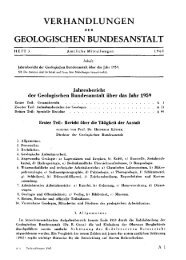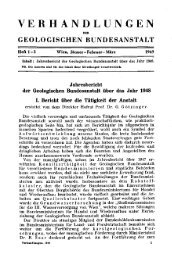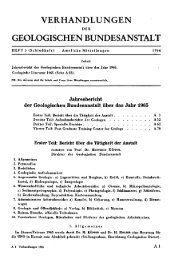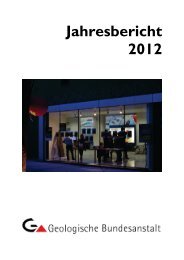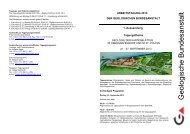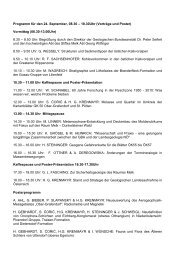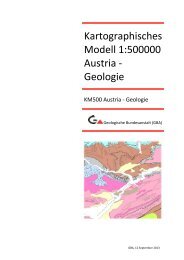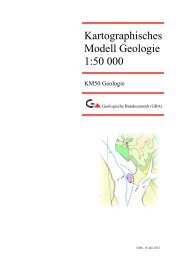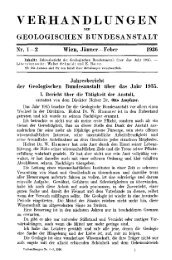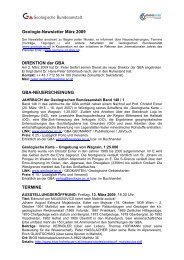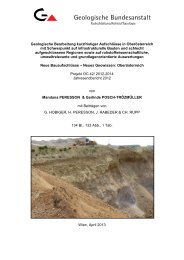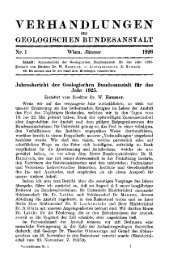Field Trip B TRIASSIC CONODONT LOCALITIES OF THE ...
Field Trip B TRIASSIC CONODONT LOCALITIES OF THE ...
Field Trip B TRIASSIC CONODONT LOCALITIES OF THE ...
You also want an ePaper? Increase the reach of your titles
YUMPU automatically turns print PDFs into web optimized ePapers that Google loves.
Fig. 14: Geological map of northern slope of Sommeraukogel. Strongly northwards dipping beds of Massiger Hellkalk<br />
(dotted) followed by Hangendrotkalk (black). Arrows indicate location of conodont sections A and B. Roman<br />
figures: topographic measure points. Modified from KRYSTYN, SCHÄFFER & SCHLAGER 1971 a.<br />
In the upper part the Hangendrotkalk passes into the Zlambach Fm.; the transitional beds with a<br />
thickness of a few meters yielded conodonts, e. g., Gondolella steinbergensis MOSHER and Misikella<br />
hernsteini (MOSTLER).<br />
According to MOJSISOVICS 1902 the fauna of the Patens-Lager represents his Patens-Zone and defines<br />
Lower Norian. In the zonal scheme of TOZER 1967 it corresponds to the Magnus Zone. From<br />
the typical beds 68/123—125 a large number of ammonoids was collected dominated by species of the<br />
genus Juvavites (for description of the species we refer to MOJSISOVICS 1873—1902); two specifically<br />
undeterminable Juvavites have also been found in the uppermost bed of the „Massiger Hellkalk" and<br />
in the overlying basal bed of the Hangendrotkalk of conodont section A (see pt. Ill, fig. 15).<br />
The upper part of section A is equivalent to the Bicrenatus-Lager of MOJSISOVICS (identical with<br />
his „Bicrenatus-Zone"). The extremely rich ammonoid fauna described by him between 1873 and 1902<br />
originated from a several meter thick horizon including also some beds of the underlying Patens-Fauna.<br />
Based on a re-study two levels can be distinguished, i. e., a lower one with the Bicrenatus-Fauna proper<br />
(Bicrenatus Zone) and an upper one which is characterized by ammonites of the genus Halorites<br />
(fig. 15, beds 68/102, 68/146 and section B, bed 4). The latter horizon which is widely distributed at<br />
Sommeraukogel has been named Halorites Beds by KRYSTYN 1973. Subsequent studies by TATZREI-<br />
TER 1978 on the Middle Norian ammonoid fauna of the Hallstatt Lst. of Timor has proved this genus<br />
to be diagnostic of the upper half of the Columbianus Zone throughout the Tethys realm. However, the<br />
main layer of Halorites can be attributed to subzone IV of TATZREITER, i. e., the highest level of the<br />
zone (TATZREITER 1978, p. 113). Hence, in section B the Middle/Upper Norian boundary mav be<br />
drawn near or at the top of bed 4 (see fig. 15).<br />
The placement of the Lower to Middle Norian boundary causes more problems: Specimens of the<br />
genus Juvavites from the basal beds 75/11 and 75/12 of section A are clearly attributed to the uppermost<br />
Lower Norian Magnus Zone. Above, i. e., within the lower division of the Bicrenatus-Lager ammonites<br />
are exceedingly rare. Since no stratigraphically diagnostic species have been found in bed 75/13<br />
or above the Lower to Middle Norian boundary can not be drawn precisely. Perhaps it corresponds to<br />
the base of bed 75/13 as is indicated by the conodont fauna (see below). Moreover, in both sections a<br />
zonal subdivision of the Bicrenatus-Lager is still lacking and probably will not be possible in the future<br />
too due to the present rare occurrences of megafossils.<br />
The Upper Norian Metternichi-Lager (fossil locality 68/55) was newly described by KRYSTYN<br />
et al. 1971; it represents the Suessi Zone in terms of ammonoid biostratigraphy. The ammonoid fauna<br />
consists of large specimens of Pinacoceras mettemichi (HAUER) and some other leiostracean forms<br />
(see KRYSTYN & SCHÖLLNBERGER 1972, p. 96). Furthermore, the uppermost bed of the Hallstatt<br />
90


